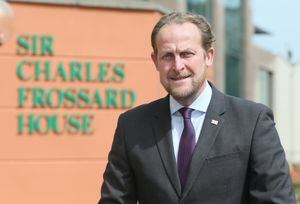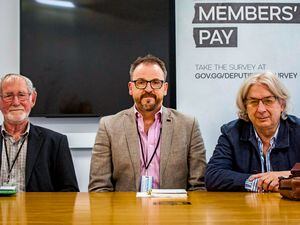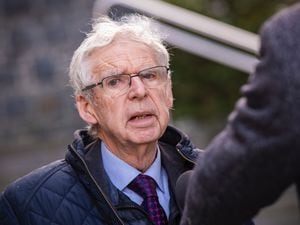'Our goal is not to simply cut staff... it is to redesign'
A NEW civil service leadership team, which means the end of individual committees having a chief secretary, is being proposed by States chief executive Paul Whitfield.

It is one of the ways he intends to reduce the number of senior civil servants while at the same time carrying out a fundamental redesign of the civil service.
This will result in the targeted removal of more than 200 posts, but, he said, ‘this specific programme does not include teachers, nurses, law enforcement officers, social workers or other public sector workers’.
He has given details of his plans in an open letter to everyone working in the public sector.
This is an edited version of it.
DEAR COLLEAGUES,
I have in recent months taken stock, looked at how far we have come and how far we have to go.
I want to take this opportunity to thank each and every one of you for getting us to this point, where I firmly believe that together we are ready for the next step; a step that can and should be bold.
As we have progressed public service reform we have made a number of changes to our structure.
However, it has become very clear that the constraints of the current structure of the civil service are not going to allow us to effectively reach our organisational goals and support the government’s aims.
Historically our civil service structure has reflected political structure, but that does not help us to work across services and it does not play to our strengths.
If we want to demonstrate a similar approach to achieving efficiencies as we have seen across many public and private sector organisations, then we need to be able to take a similar approach to organising our resources. We must do this without compromising the support given to committees.
We need to be structured in a way that is more efficient, that removes the silos that still exist despite our success to date, and that allows us to truly work as one organisation – all of which will help us better serve the public, which is our absolute focus.
As such, I have decided to make significant changes to the leadership structure at the top of the civil service before the end of 2018.
The new leadership team
The new structure will group strategic responsibility by services and customer need across government.
This will join up services at the highest level and in turn provide greater support for committees from strategic leaders freed up from operational responsibility.
In addition there will be senior operational leads for each committee with additional specific officer support to ensure the effective running of committee business.
The new civil service leadership team will comprise of six roles, rather than the 13 at present (please note the list of responsibilities is illustrative and not exhaustive):
. The chief executive;
. Strategic lead for supporting government – including responsibility for legislation, cross-government policy development, committee support, government business, external relations;
. Strategic lead for finance & investment – including the financial strategy, the Revenue Service, all Treasury functions including the fiscal framework and tax policy, the capital portfolio;
. Strategic lead for people policies – including responsibility for policy development and implementation on areas such as children’s services, adult services, public health, education and lifelong learning, inclusion and equality, employment, social security benefits and social housing;
. Strategic lead for place policies – economy and productivity, planning and development, regulation, transport, infrastructure, environment services, energy, justice; and
. Strategic lead for delivery and support services – operations, HR, digital and information services, procurement, property and facilities.
In addition, I will oversee seven States-wide support services which will underpin transformation activities – change and transformation; communications; workforce/organisational design; customer experience; data and performance; compliance and assurance; and a portfolio office.
Supporting the committees
The traditional role of chief secretary will be removed and support for principal committees will be strengthened in the following ways:
. The strategic lead for people policy will provide high-level cross-committee policy advice and support for Health & Social Care, Education, Sport & Culture and Employment & Social Security
. The strategic lead for place policy will provide high-level cross-committee policy advice and support for Economic Development, Home Affairs and Environment & Infrastructure
. A committee secretary with responsibility for day-to-day business and governance
. A specific and accountable operational lead(s)
This combination of roles, with clear lines of accountability, will ensure committees receive excellent well-rounded support from the senior civil service, while joining up the lead and development of strategy and policy across government.
Fundamental redesign of the civil service
Once the new leadership team is in place by the end of this year, they will lead and implement (by the end of 2020) a fundamental redesign of the entire civil service. This will be supported by the two related activities of:
. the de-layering of the civil service and reduction in the number of senior civil servants
. the redesign of all processes and services, which will involve digitising services and a reduction in the number of more junior posts.
This redesign will result in the targeted removal of more than 200 civil service posts – it is important to emphasise this specific programme does not include teachers, nurses, law enforcement officers, social workers or other public sector workers.
It is crucial, and I cannot stress this enough, to understand that the sustainable reduction of civil service posts will not be achieved by simply doing what we do today but with fewer people.
To achieve this, we must and will:
. fundamentally change the way we think about services and how we deliver them;
. break down the barriers and silos that exist in our current organisational structure;
. redesign our services to focus on what it is service users are trying to access and enabling them to do so as easily and painlessly as possible; and
. take services online wherever it is practical to do so and automate as many of the processes needed to deliver them as possible.
Significant financial benefits will be delivered over the two-year period of 2019–2020, estimated to be in the range of at least £10m. per annum recurring once all changes have been implemented. These figures could increase as the redesign progresses.
The 2019 Budget contains a recommendation to release initial funding of £8m. to run the civil service redesign programme, including a targeted voluntary redundancy scheme.
Again, and for absolute clarity, this will be voluntary at this stage.
It is important for all colleagues to understand from the outset that staff will only be considered for targeted voluntary redundancy if roles can be removed as a result of a service doing things differently.
Our goal is not to simply cut staff, or let colleagues go when they are providing a critical role. This is about redesigning our civil service to better serve our customers and identifying roles we no longer need as part of a targeted voluntary redundancy programme.
I hope that many of you will see this as a challenge that you want to be part of and as an opportunity – and there will be opportunities within the new structure.
The next 18 months will be a period of significant and exciting change. I know, however, that there will be some who won’t feel that they want to be part of this change.
We will provide further information about the targeted voluntary redundancy programme as soon as we can.
This may not be until the new year given it is reliant on us appointing the senior leadership team and that team completing initial work on the fundamental redesign of the civil service.
Whenever I have been asked about staff numbers and staff costs, my response has always been the same – it’s important that the States of Guernsey has no more or less staff than we need.
We currently have in the region of 1,600 civil servants. A reduction of more than 200 posts is significant, but achievable.
We know that Guernsey currently has many vacancies in the private sector and we’ll be releasing skilled staffed into the island’s workforce.
If we do this the right way – by truly redesigning how we deliver services, by maximising technology and by delayering the senior civil service – then the benefits will be felt by us, by our customers, in the public purse, by the political body and by the wider economy.
I am under no illusions that this is a significant programme of change. I am, however, absolutely confident that it will be delivered.





